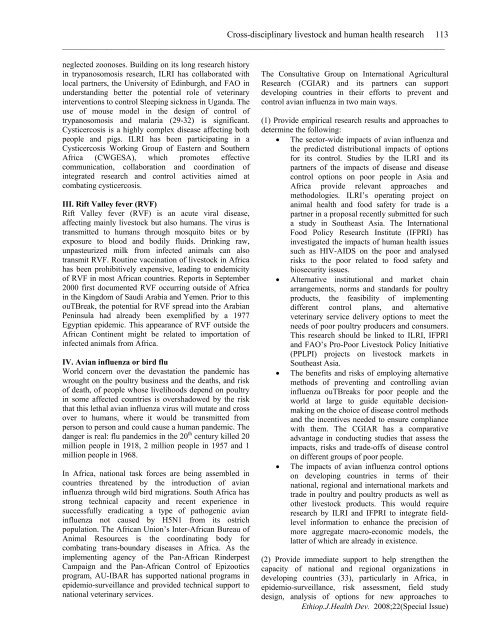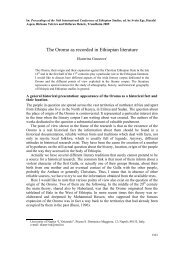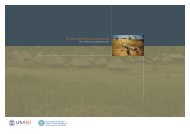Create successful ePaper yourself
Turn your PDF publications into a flip-book with our unique Google optimized e-Paper software.
Cross-disciplinary livestock and human health research 113<br />
______________________________________________________________________________________<br />
neglected zoonoses. Building on its long research history<br />
in trypanosomosis research, ILRI has collaborated with<br />
local partners, the University of Edinburgh, and FAO in<br />
understanding better the potential role of veterinary<br />
interventions to control Sleeping sickness in Uganda. The<br />
use of mouse model in the design of control of<br />
trypanosomosis and malaria (29-32) is significant.<br />
Cysticercosis is a highly complex disease affecting both<br />
people and pigs. ILRI has been participating in a<br />
Cysticercosis Working Group of Eastern and Southern<br />
Africa (CWGESA), which promotes effective<br />
communication, collaboration and coordination of<br />
integrated research and control activities aimed at<br />
combating cysticercosis.<br />
III. Rift Valley fever (RVF)<br />
Rift Valley fever (RVF) is an acute viral disease,<br />
affecting mainly livestock but also humans. The virus is<br />
transmitted to humans through mosquito bites or by<br />
exposure to blood and bodily fluids. Drinking raw,<br />
unpasteurized milk from infected animals can also<br />
transmit RVF. Routine vaccination of livestock in Africa<br />
has been prohibitively expensive, leading to endemicity<br />
of RVF in most African countries. Reports in September<br />
2000 first documented RVF occurring outside of Africa<br />
in the Kingdom of Saudi Arabia and Yemen. Prior to this<br />
ouTBreak, the potential for RVF spread into the Arabian<br />
Peninsula had already been exemplified by a 1977<br />
Egyptian epidemic. This appearance of RVF outside the<br />
African Continent might be related to importation of<br />
infected animals from Africa.<br />
IV. Avian influenza or bird flu<br />
World concern over the devastation the pandemic has<br />
wrought on the poultry business and the deaths, and risk<br />
of death, of people whose livelihoods depend on poultry<br />
in some affected countries is overshadowed by the risk<br />
that this lethal avian influenza virus will mutate and cross<br />
over to humans, where it would be transmitted from<br />
person to person and could cause a human pandemic. The<br />
danger is real: flu pandemics in the 20 th century killed 20<br />
million people in 1918, 2 million people in 1957 and 1<br />
million people in 1968.<br />
In Africa, national task forces are being assembled in<br />
countries threatened by the introduction of avian<br />
influenza through wild bird migrations. South Africa has<br />
strong technical capacity and recent experience in<br />
successfully eradicating a type of pathogenic avian<br />
influenza not caused by H5N1 from its ostrich<br />
population. The African Union’s Inter-African Bureau of<br />
Animal Resources is the coordinating body for<br />
combating trans-boundary diseases in Africa. As the<br />
implementing agency of the Pan-African Rinderpest<br />
Campaign and the Pan-African Control of Epizootics<br />
program, AU-IBAR has supported national programs in<br />
epidemio-surveillance and provided technical support to<br />
national veterinary services.<br />
The Consultative Group on International Agricultural<br />
Research (CGIAR) and its partners can support<br />
developing countries in their efforts to prevent and<br />
control avian influenza in two main ways.<br />
(1) Provide empirical research results and approaches to<br />
determine the following:<br />
• The sector-wide impacts of avian influenza and<br />
the predicted distributional impacts of options<br />
for its control. Studies by the ILRI and its<br />
partners of the impacts of disease and disease<br />
control options on poor people in Asia and<br />
Africa provide relevant approaches and<br />
methodologies. ILRI’s operating project on<br />
animal health and food safety for trade is a<br />
partner in a proposal recently submitted for such<br />
a study in Southeast Asia. The International<br />
Food Policy Research Institute (IFPRI) has<br />
investigated the impacts of human health issues<br />
such as HIV-AIDS on the poor and analysed<br />
risks to the poor related to food safety and<br />
biosecurity issues.<br />
• Alternative institutional and market chain<br />
arrangements, norms and standards for poultry<br />
products, the feasibility of implementing<br />
different control plans, and alternative<br />
veterinary service delivery options to meet the<br />
needs of poor poultry producers and consumers.<br />
This research should be linked to ILRI, IFPRI<br />
and FAO’s Pro-Poor Livestock Policy Initiative<br />
(PPLPI) projects on livestock markets in<br />
Southeast Asia.<br />
• The benefits and risks of employing alternative<br />
methods of preventing and controlling avian<br />
influenza ouTBreaks for poor people and the<br />
world at large to guide equitable decisionmaking<br />
on the choice of disease control methods<br />
and the incentives needed to ensure compliance<br />
with them. The CGIAR has a comparative<br />
advantage in conducting studies that assess the<br />
impacts, risks and trade-offs of disease control<br />
on different groups of poor people.<br />
• The impacts of avian influenza control options<br />
on developing countries in terms of their<br />
national, regional and international markets and<br />
trade in poultry and poultry products as well as<br />
other livestock products. This would require<br />
research by ILRI and IFPRI to integrate fieldlevel<br />
information to enhance the precision of<br />
more aggregate macro-economic models, the<br />
latter of which are already in existence.<br />
(2) Provide immediate support to help strengthen the<br />
capacity of national and regional organizations in<br />
developing countries (33), particularly in Africa, in<br />
epidemio-surveillance, risk assessment, field study<br />
design, analysis of options for new approaches to<br />
Ethiop.J.Health Dev. <strong>2008</strong>;22(Special Issue)







